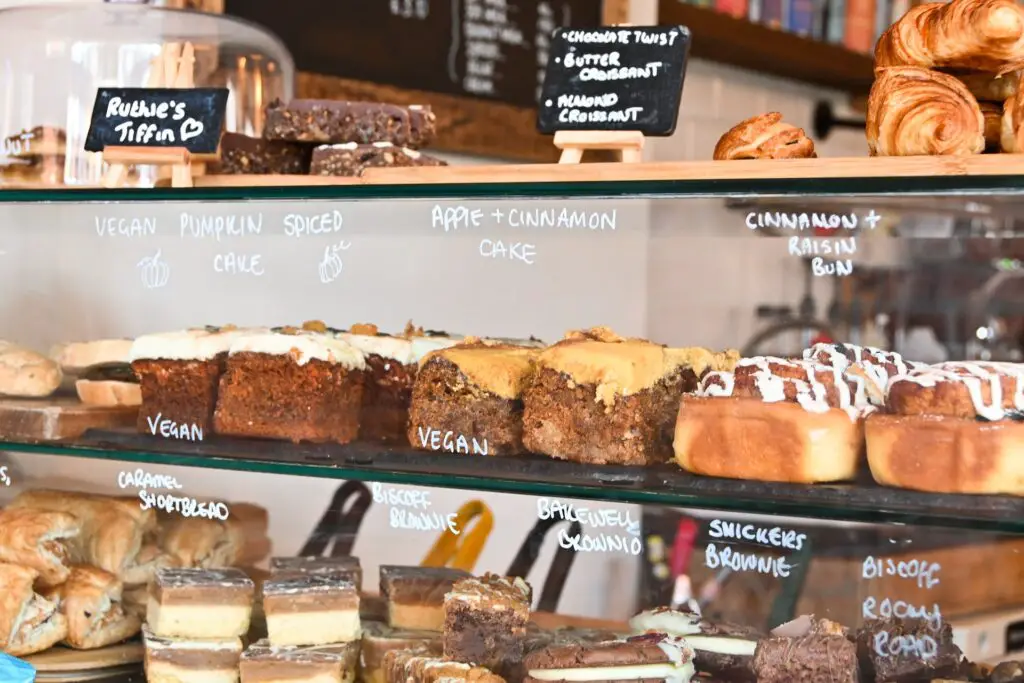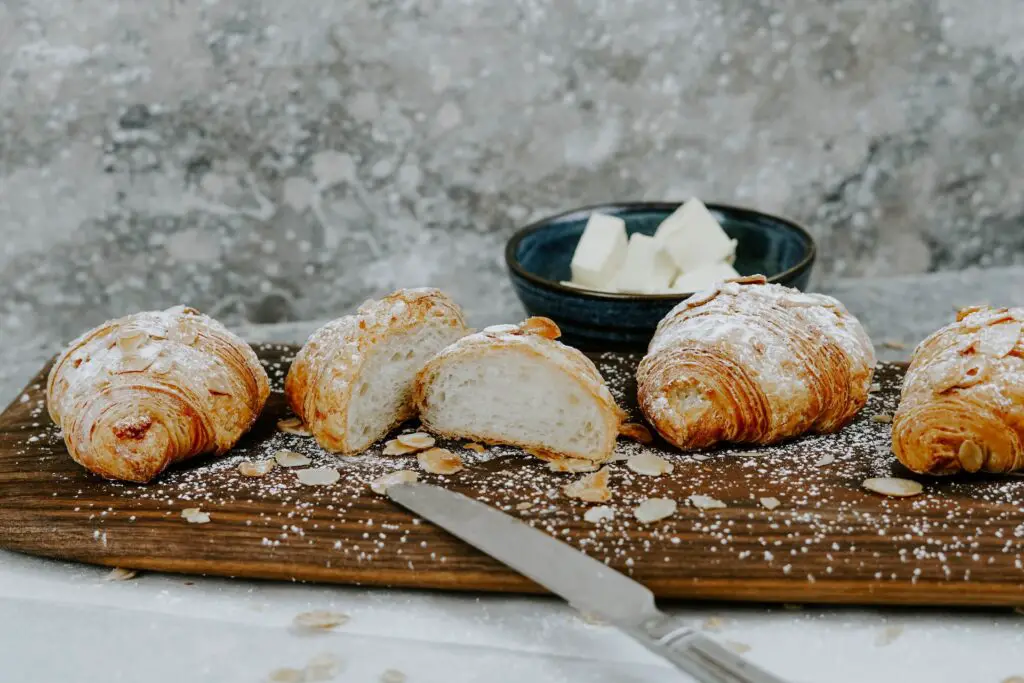Vegan croissants have gained popularity over the years as more and more people adopt plant-based diets and crave the buttery, flaky goodness of this classic French pastry without the use of animal products. Creating the perfect vegan croissant requires skill, patience, and ingredients to achieve the desired taste and texture. In this article, we’ll guide you through making delicious vegan croissants from scratch.
The main challenge in crafting vegan croissants is finding the right substitute for butter, a key component of traditional croissants. Selecting a high-quality vegan butter or margarine is essential for achieving the desired results. Additionally, it’s important to understand the techniques involved in laminating and shaping the dough, as well as mastering a basic recipe that can be easily adapted to create a variety of vegan croissant flavors and fillings.
Key Takeaways
- Vegan croissants are a popular alternative to traditional French pastries, requiring specific ingredients and techniques
- High-quality vegan butter or margarine is essential for achieving the desired texture and flavor
- Mastering a basic recipe allows for versatility in flavors and fillings, as well as the opportunity for troubleshooting issues

Understanding Vegan Croissants
Vegan croissants are a popular pastry option that caters to those who adhere to a plant-based diet. These pastries are made with a special laminated dough containing no animal-derived ingredients, ensuring they are suitable for vegans.
The process of making vegan croissants involves creating a laminated dough, which consists of layers of dough and a vegan butter substitute. This dough is then folded and rolled multiple times to create the flaky, airy texture that croissants are known for. Like traditional croissants, vegan croissants are typically crescent-shaped and have a golden-brown outer crust.
One of the primary challenges in making vegan croissants is finding a suitable replacement for the butter traditionally used in laminating the dough. Vegan butter substitutes are often made from a combination of oils and emulsifiers that mimic the properties of dairy butter. However, the taste and texture of the final pastry can vary depending on the specific type of vegan butter used.
Vegan croissants can be enjoyed plain or with various fillings such as fruit preserves, nut butter, or chocolate. When creating a flaky and delicious vegan croissant, using the right ingredients and technique is crucial. With careful attention to detail and mastery of the laminating process, vegan croissants can be just as satisfying and indulgent as their non-vegan counterparts.
Essential Ingredients
Vegan croissants require a few key ingredients to achieve that delicious flakiness and rich flavor typically associated with traditional croissants. Choosing and combining these ingredients will create a scrumptious, cruelty-free pastry for everyone.
Flour is the base of the croissant dough. It’s recommended to use all-purpose flour, which provides a good balance between elasticity and tenderness in the finished product. When it comes to sugar, it plays a role in providing a hint of sweetness while also helping the croissants to develop a nice golden brown exterior when baked. Salt is necessary to enhance the flavors of the other ingredients and create a well-balanced taste.
Water and yeast are essential for making the dough rise. Different types of yeast are available, such as instant yeast, dry yeast, and active dry yeast. Instant yeast is a popular choice as it’s easy to mix with the other ingredients and speeds up the rising process.
One major factor that sets vegan croissants apart from traditional ones is vegan butter. Various brands of vegan butter are on the market, like Earth Balance and margarine. The right vegan butter should have a high-fat content to provide the essential layers and a smooth, melt-in-your-mouth texture to the croissants.
An egg wash is typically used in traditional croissant recipes to give the pastry a glossy finish. A combination of maple syrup and plant-based milk, such as soy or almond milk, can be used to replicate this effect for a vegan croissant. Simply brush the mixture onto the croissants before baking to achieve that glossy and golden brown exterior.
The essential ingredients for making delectable vegan croissants are all-purpose flour, sugar, salt, water, yeast, vegan butter, and a vegan egg wash made from maple syrup and plant-based milk. With these ingredients and proper technique, it’s possible to create flaky, delicious, and compassionate croissants that everyone will love.

Basic Recipe and Method
To create delicious vegan croissants, follow this simple recipe and method. First, gather all necessary ingredients, including a high-quality vegan butter substitute, unbleached all-purpose flour, active dry yeast, sugar, salt, and almond milk.
First, heat the almond milk to a lukewarm temperature, not exceeding 110°F (43°C). Combine the warmed almond milk, sugar, and active dry yeast in a large bowl or a stand mixer. Stir the mixture and let it sit for about 5 minutes or until frothy. Next, add the flour and salt to the mixture, gradually incorporating it until a dough forms.
Knead the dough using a stand mixer with a dough hook attachment or by hand on a lightly floured surface until it becomes smooth, elastic, and not too sticky. Form the dough into a ball and place it in a greased bowl. Cover the bowl with a damp cloth or plastic wrap, and allow the dough to rise in a warm, draft-free environment for around 1.5-2 hours or until it has doubled.
While the dough is rising, prepare the vegan butter. Be sure to utilize a high-quality vegan butter substitute suitable for baking. Shape the butter into a thin square or rectangle, about 1/4-inch thick. Wrap the vegan butter in plastic wrap and freeze it for around 30 minutes to ensure it is firm but still pliable.
Roll the dough out on a floured surface into a large rectangle about 1/2 inch thick to laminate it. Place the vegan butter in the center of the rectangle and fold the dough over the butter, encasing it completely. Roll out the dough again into a large rectangle, then fold it in thirds, like a business letter. Wrap the dough in plastic wrap and refrigerate it for 1 hour. Repeat this rolling and folding process two more times.
After the final folding, preheat your oven to 400°F (200°C) and prepare a baking sheet with parchment paper or a silicone baking mat. Roll out the dough once more, cutting it into triangles. Roll up the triangles from the widest end to form the classic croissant shape. Place them onto the prepared baking sheet, giving them enough space in between for expansion as they bake.
Brush the tops of the vegan croissants with a mixture of almond milk and maple syrup for a golden color and a touch of sweetness. Bake for 20-25 minutes or until the croissants are golden brown and flaky.
Serve these vegan croissants warm as a delightful snack, breakfast, or brunch option, knowing that they adhere to the principles of vegan baking and embody homemade perfection.
Laminating the Dough
Laminating the dough is a crucial step in making vegan croissants. This process involves creating thin layers of dough and fat, usually a plant-based butter substitute, to provide the flaky texture that croissant lovers crave. Prepare a butter square or butter block using the chosen vegan butter substitute to start the lamination process.
Using a rolling pin, gently roll the dough into a rectangular shape, ensuring it is slightly larger than the butter square. Carefully place the butter block in the rolled dough’s center and fold it around the butter, fully enclosing it. This creates the beurrage, which will be used to create multiple layers.
Next, gently roll the beurrage into a larger rectangle, keeping the layers even. Once the desired size is achieved, fold the dough into thirds, like a letter. This is the first fold in the lamination process. Wrap the dough in plastic wrap and let it rest in the refrigerator for about 30 minutes, allowing the vegan butter to firm up.
After resting, remove the dough from the refrigerator and roll it into an even rectangle. Fold it in thirds once more, wrap it in plastic wrap, and refrigerate for another 30 minutes. Repeat this rolling and folding process at least twice to create the desired number of layers in the dough. Allowing the dough to rest between each folding session is essential, as this helps maintain the necessary temperature and consistency for successful lamination.
While working with the dough, be mindful of how it feels and reacts to the rolling and folding. Over-kneading the dough or using excessive force may cause the layers to combine, resulting in a loss of the flaky texture. A gentle touch and even rolling motion will preserve the integrity of the layers.
In conclusion, the lamination process is crucial to creating vegan croissants with a satisfying flaky texture. The desired layers can be achieved by carefully rolling, folding, and allowing the dough to rest between each step, leading to a delicious and successful finished product.
Shaping the Croissants
Prepare the dough with flour, water, sugar, salt, and dairy-free butter to shape vegan croissants. Ensure that the dough is smooth and elastic, and allow it to rest to aid in gluten development.
After the dough has rested, roll it out into a large rectangle. Spread the chilled vegan butter on the dough, leaving a small border on all sides. Fold the dough over the butter to encase it completely and seal the edges.
Next, performing a series of folds is essential, ultimately creating distinct layers in the croissants. Carefully roll the encased dough into a long rectangle, then fold it into thirds, like a letter. Wrap the dough in plastic and chill it in the refrigerator for about 30 minutes. Repeat this process at least 3 more times for optimal layering.
Once the folding process is complete, remove the dough from the refrigerator and let it rest for about 10 minutes. This will make it easier to roll and cut. Roll out the dough into a large rectangle, roughly 1/4 inch in thickness. Use a sharp knife or pizza cutter to slice it into smaller rectangles and then diagonally cut each rectangle into triangles.
To shape the croissant, gently stretch the triangle to elongate it, then place it on the work surface with the long point facing away. Start at the wide end, tightly yet gently roll the dough, carefully not to crush the layers. Curl the ends of each rolled croissant toward its center to form a crescent shape.
Place the shaped croissants on a parchment-lined baking sheet, leaving enough space for them to rise during the proofing and baking process. Lightly cover them with a clean kitchen towel, and let them proof until noticeably puffy and nearly doubled in size.
Variations of Vegan Croissants
Vegan croissants come in various flavors and fillings, catering to diverse tastes and preferences. One popular variation is the chocolate croissant or pain au chocolat. Instead of traditional chocolate, bakers use vegan chocolate made from ingredients like cocoa butter, cocoa powder, and sugar without any milk products. This provides the rich taste of a classic chocolate croissant while adhering to a plant-based lifestyle.
Another variation includes cheese croissants made with vegan cheese. Vegan cheese is usually crafted from nuts, seeds, or soy-based ingredients, offering a similar texture and flavor to dairy cheese. Some bakers utilize vegan cream cheese, while others opt for plant-based cheddar or mozzarella-style cheese. This provides a delicious, savory option for those who enjoy a cheesy twist on their croissant.
Additionally, vegan croissants can feature fruity fillings, such as jam. Choosing a natural, gelatin-free jam creates a sweet and fruity center for a delightful pastry. Possible jam flavors include raspberry, strawberry, blueberry, or even apricot, allowing for various choices depending on personal preferences.
In summary, vegan croissants offer diverse flavors and fillings, from the indulgent chocolate croissant to the savory cheese croissant and the fruity jam-filled pastry. Each variation provides a unique and delicious experience for those who follow a vegan lifestyle or wish to explore new plant-based culinary alternatives.

Baking Tips and Troubleshooting
When making homemade vegan croissants, following a step-by-step guide can be helpful. However, it’s also important to learn some baking tips and troubleshooting solutions for common issues that may arise during the process.
To ensure a light and flaky texture, it is essential to use cold vegan butter or margarine when laminating the dough. This will help create the distinct layers found in croissants. Be sure to work quickly, as the butter can melt and become difficult to incorporate properly if left at room temperature for too long.
When rolling out the dough, apply gentle and even pressure. Overworking the dough can cause the layers to blend, negatively impacting the finished product. While shaping the croissants, remember that the tighter you roll them, the more pronounced the inner-layered structure will be.
During the proofing stage, it’s critical to maintain the right temperature and humidity levels. Croissants may not rise correctly if the environment is too warm or dry. Aim for a temperature between 75-80°F (24-27°C) with 70-80% humidity. It might take approximately 1.5-2 hours for croissants to double in size.
Keep an eye on the baking process and adjust the oven temperature as needed based on the color of the croissants. If they brown too quickly, reduce the temperature by 25°F (14°C) and monitor closely. Conversely, if they are still pale after the recommended baking time, increase the temperature slightly and continue to bake until golden.
Here are some common troubleshooting scenarios:
- Croissants are too dense: This may be due to overworked dough or insufficient proofing. Be gentle when laminating and give the croissants ample time to rise.
- Layers didn’t form: Ensure the vegan butter is cold, work quickly, and use appropriate rolling techniques during the lamination process.
- Croissants didn’t rise: Verify that the yeast is still active and follow the right temperature and humidity conditions during proofing.
By following these tips and being mindful of potential issues, producing delicious vegan croissants at home will become more achievable with each attempt.
Nutritional Information
Vegan croissants are known for their flavorful and satisfying nature. The nutritional profile of these pastries is often quite similar to their traditional counterparts.
A vegan croissant contains around 300-350 calories per standard 75g serving. It generally provides approximately 40-45g of carbohydrates, mainly from wheat flour and can vary depending on the ingredients used. Most vegan croissants primarily contain complex carbs crucial for sustaining energy.
Regarding fat content, vegan croissants usually have a lower amount of saturated fat than non-vegan alternatives. This is primarily due to the absence of butter, which is high in saturated fat. Instead, vegan croissants use plant-based fats such as oils or margarine, resulting in a healthier fat profile. Although the total fat content in a vegan croissant might remain somewhat similar to its non-vegan version, hovering around 17-20g per serving, the type of fat used significantly affects its nutritional value.
Protein content can vary from one vegan croissant to another. These pastries provide around 5-6g of protein per serving. This protein mainly originates from the flour, although additions such as seeds or nuts can further contribute to the protein content.
Vegan croissants are relatively low in sodium, typically around 200-250mg per serving. However, consuming multiple pastries throughout the day can quickly increase sodium intake.
As for the vitamin and mineral content, vegan croissants provide essential nutrients such as iron, potassium, and calcium. Iron is essential for maintaining healthy blood and immune system functioning, while potassium is vital in maintaining proper fluid balance and muscle function. Calcium, on the other hand, is crucial for healthy bones and teeth. However, due to their pastry nature, vegan croissants should not be relied upon as a primary source of these nutrients, and a balanced diet should always be maintained for optimal health.
Frequently Asked Questions
Where can I find vegan croissant brands?
Vegan croissants can be found at local health food stores, specialty bakeries, and supermarkets. Brands such as La Boulangerie and Schar offer vegan croissants. Online retailers like Vegan Essentials and Amazon also provide various vegan croissant options.
Are there frozen vegan croissants available?
Yes, frozen vegan croissants are available for purchase. Brands like Fauxmagerie Zengarry, Organic Bread of Heaven, and Nature’s Bakery offer frozen vegan croissants conveniently stored and baked at home.
How to make vegan croissants without yeast?
Vegan croissants without yeast can be made using a combination of ingredients, such as baking powder and vegan butter. Substitute yeast with a larger quantity of baking powder, and follow a standard vegan croissant recipe, making sure to use quality vegan butter or margarine for a flaky pastry.
Which is the best vegan butter for croissants?
High-quality vegan butter or margarine is essential for achieving a flaky texture in vegan croissants. Brands like Miyoko’s Creamery, Earth Balance, and Naturli offer excellent vegan butter options for pastry-making.
Are whole foods vegan croissants available?
Whole Foods Market often carries vegan croissants in their bakery section. However, availability may vary depending on the location and time. It is recommended to call your local store to check if they have vegan croissants in stock.
What are the calories in a vegan croissant?
The calorie content of vegan croissants varies depending on ingredients, serving size, and preparation method. On average, a vegan croissant contains approximately 250-350 calories. To determine the exact calorie count, consult the nutrition information on the packaging or look for nutritional details in a recipe if preparing vegan croissants at home.

